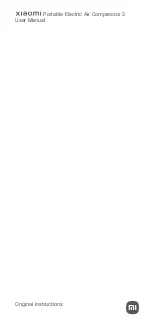
3.0 Installation
_________________________________________________________________________________________
CC1132751C 9
3.0 Installation
CAUTION !
LIFTING AND TRANSPORTATION MUST ONLY
BE CARRIED OUT BY AUTHORISED PERSONS.
ENSURE ALL EQUIPMENT EXCEEDS THE FULL
LOAD OF THE UNIT.
3.1 Lifting and Handling
A fork lift or pallet truck are the most suitable means of moving
the product. Pay particular attention to ensure stability to prevent
the unit tilting over.
Lift the hypac or compressor and place in the desired location,
damage to mountings may occur if you slide the compressor into
position.
3.2 Compressor Location
Position the compressor/hypac in a room of adequate size on a
firm surface, level in both planes within five degrees of the
horizontal.
Ensure the area has sufficient load-bearing capacity, provide
access, 1 metre/3.3 ft for routine service procedures around and
above the unit.
Site the compressor/hypac away from sources of dirt, coarse
solids, abrasive particles, steam, liquids and gaseous impurities.
This is an industrial compressor and is intended for installation in
an indoor environment.
Any air connection made to the compressor outlet must be
flexible as the base incorporates resilient mountings.
3.3 Compressor Ventilation (Fig.3.1)
Position the compressor/hypac in a well ventilated location. Do
not restrict the air-flow around the compressor or allow the hot
air discharge to re-circulate into the compressor intake.
Fig 3.1 Compressor Ventilation
Any cooling-air inlet (A) should be positioned low allowing
unrestricted air-flow to the compressor intake. The warm-air
outlet (B) should be positioned high, and well away from the
inlet, to ensure a positive cooling air-flow through the
compressor.
For maximum efficiency and reliability, the compressor should be
operated in a moderate ambient temperature. If temperatures
frequently fall below 0°C (32°F), a different grade of oil may be
required.{Recommended HPO 198)
Compressor air intake and exhaust grills have captive nuts fitted
as standard to attach ducting.
Air ducting, if fitted, must not cover or restrict the cooling air flow
of the compressor. Total resistance of the system must not
exceed 50 mbar. If resistance is expected to be greater, fan
assistance will be required.
3.4 Electrical Connections
WARNING !
CONNECTION TO, OR INSTALLATION OF, AN
ELECTRICAL POWER SUPPLY MUST ONLY BE
CARRIED OUT BY QUALIFIED ELECTRICIANS.
THE INSTALLATION MUST MEET THE WIRING
REGULATIONS PRESENTLY IN PLACE.
Before connecting to the mains electrical supply, ensure that the
system can sustain the additional electrical load. To ensure
reliable low resistance joints, make sure that your incoming
supply cables are firmly secured to the starter terminals and that
they are of correct size.
NOTE !
The starter door panel should always be secured by the
supplied key for safety reasons and to prevent unauthorized
access.
Refer to starter circuit diagrams (located inside the starter door
panel) before starting work. The instructions given for earthing,
fuses and cable size are important.
Fuses to BS 88 (Type gG) must be used to protect the starter,
refer to the sizes specified on the starter circuit diagrams.
Circuit breakers are not recommended since they may not fully
protect the starter contacts in an overload condition.
Water drain, filters or dryers fitted downstream of the
compressor discharge must be correctly sized to avoid
excessive flow restrictions to ensure stable operation of the
speed control system.
3.5 Electrical Installation (Fig 3.2)
WARNING !
BEFORE STARTING WORK ENSURE THAT THE
MAIN-LINE FUSES HAVE BEEN REMOVED
FROM THE DISTRIBUTION BOARD.
PRECAUTIONS SHOULD BE TAKEN TO
PREVENT THEM BEING REFITTED UNTIL THE
INSTALLATION IS COMPLETE.
Starter cables must be connected to the mains electrical supply
via a lockable, switched and suitably rated fused isolator. The
isolator should be positioned as near as possible to the
compressor with clear, unrestricted access.
To access starter terminals, unlock the starter door panel and
pass incoming cables through the entry hole in the floor for
HR04-HR07.
Connect the three mains supply cables to the terminals marked
L1, L2 and L3, and connect the earth cable to the earth terminal
E. Ensure the connections are secure.
Refer to IEEE Regulations for electrical equipment installed in
buildings to determine the size required, pay particular attention
to the circuit diagrams provided.
A
B
Summary of Contents for HR04
Page 1: ...HR04 HR07 Models User Handbook Original Instructions CC1132751D 10 2018 GB...
Page 2: ......
Page 23: ......










































